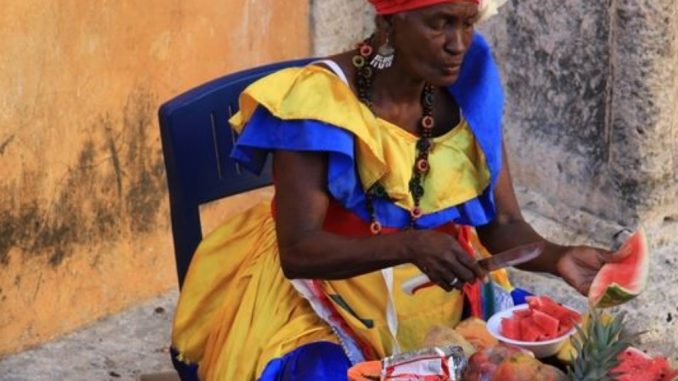
Colombia, South America in her traditional African Heritage style dress and selling fruits. Afro-Colombians are Colombians of African ancestry. They constitute about 26% of the Colombian population today, about 11 million people. However, 20% of the Afro-Colombian population self-identifies as having African descendants according to the PERLA (Project on Ethnicity and Race in Latin America) study.
San Basilio de Palenque is considered the first village of free slaves in South America, as well as the birthplace of the African cultural wealth of Colombia. They make up the second largest African descendant population in Latin America, after Brazil. Afro-Colombians have impacted immensely on Colombian culture and the general socio-economic milieu. The largest populations of Afro-Colombians live in the departments on the Atlantic and Pacific coasts where they constitute as much as 80% of the populace (DANE, Colombia: una nación multicultural). Afro-Colombians are the African descendants whose diverse culture reflect almost every black African ethnic group.
On the Colombian Caribbean Coast, at a distance of one hour from the city of Cartagena, between mountains and swamps, there is a place where, in spite of the passage of time, its inhabitants live guided by African customs, traditions and rites, just as their ancestors did several centuries ago.
This place, known as San Basilio de Palenque, is famous for its symbol, the palenqueras, dark-skinned women who, dressed in multicolored dresses and swaying their hips, walk while they balance bowls of fresh fruit on their heads. Its inhabitants prefer to have their community called San Basilio de Palenque not Palenque de San Basilio, with the argument that the village does not belong to the saint, rather it is the other way around.
The palenqueras are the image representing the difficult, complicated history of their ancestors. They symbolize the struggles of the black cimarrones – slaves who courageously escaped from their owners in search of a better future.
Since the 15th century, San Basilio de Palenque is considered the first village of free slaves in South America, as well as the birthplace of the African cultural wealth of Colombia. The palenqueras preserve the African traditions brought by the slaves who disembarked on these regions of the South American continent during the Spanish Conquesti. Soon after, in colonial times, palenques began to appear on the mountains.
These were settlements of rebellious cimarrones. The term “palenque” turned into a symbol of freedom because anyone who became a member of one was automatically free.
BY: Kweku Darko Ankrah
